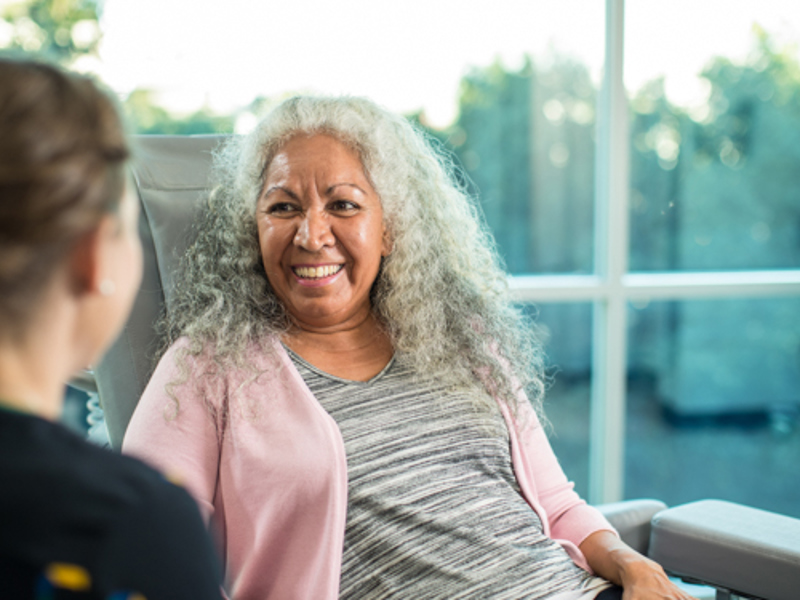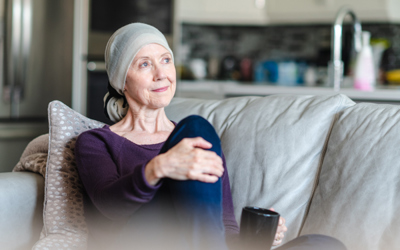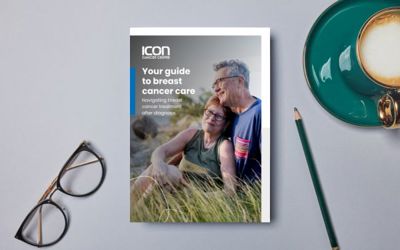What are the treatment options for breast cancer?
The treatment options for breast cancer may include surgery, chemotherapy, immunotherapy, radiotherapy, hormone therapy and targeted therapies. The type of treatment you receive will depend on several different considerations, such as the type of breast cancer you have, its stage – which takes into account the size of the breast cancer and if the lymph glands (also known as lymph nodes) contain cancer cells, your overall health and your treatment preferences. This page aims to give you a comprehensive overview of how breast cancer treatment works.

Surgery for breast cancer
Surgery is commonly performed for people with breast cancer to remove cancerous tissue, identify whether the cancer has spread to the lymph nodes and, if possible, restore the breast’s shape. Most people with breast cancer will receive surgery at some point during their treatment.
There are two types of surgery: breast conservation, also known as a lumpectomy, where the cancer is removed with a rim of normal tissue, or a mastectomy where the entire breast is removed.
After breast conservation surgery, a course of radiotherapy is typically recommended.
Cancer cells can travel from the breast in channels called lymphatic vessels and collect in nearby lymph nodes. To find out if the breast cancer has spread to lymph nodes in your underarm, one or more of these lymph nodes will be removed and looked at under the microscope. The most common form of lymph node surgery is called a sentinel node biopsy.
The sentinel lymph nodes are the first lymph nodes(s) that breast tissue, in the area of the tumour, drain into. This procedure may require injection of a special form of dye into the breast just prior to the surgery. A nuclear scan, called lymphoscintigraphy, and/or blue dye helps the surgeon locate the sentinel lymph nodes at the time of surgery.
If a sentinel lymph node biopsy is not appropriate or possible in your case, the surgeon will usually perform an axillary dissection. This is when the surgeon removes most of the lymph nodes from the armpit, also called the axilla. Every person has a different number of axillary lymph nodes. An axillary dissection may also be recommended if cancer cells are found in your sentinel lymph nodes. This can occur as part of your breast cancer surgery or as a separate operation.
Lumpectomy
A lumpectomy, also known as breast-conserving surgery or partial mastectomy, is a procedure which focuses on removing the least amount of healthy tissue as possible when excising the breast cancer tumour/s. Lumpectomy may help in maintaining the appearance of your breast. Most women will be recommended radiotherapy after a lumpectomy.
Mastectomy
Mastectomy refers to the surgical removal of the entire breast to prevent or treat breast cancer. There are many different types of mastectomies performed today including:
Total mastectomy
Removal of the entire breast including the nipple, areola and skin.
Skin-sparing mastectomy
Removal of the breast tissue, nipple and areola but not the skin. This offers an improved appearance but may not be suitable for certain cancers.
Nipple-sparing mastectomy
Removal of the breast tissue but not the skin or nipple. This may be an option for small, early tumours that do not affect the nipple or skin.
Bilateral mastectomy
Removal of both breasts. This is often a preventive surgery for women at high risk of breast cancer, especially those who have the BRCA gene mutation which predisposes them to breast cancer.
Chemotherapy for breast cancer
Chemotherapy uses a range of drugs to kill and slow the growth of breast cancer cells. These drugs may be delivered at any stage of your breast cancer treatment, from shrinking large tumours before surgery to destroying potential remaining cancer cells after surgery. Chemotherapy plays an important part in reducing the risk of your breast cancer returning in both the breast and the rest of the body.
Learn more about chemotherapy and how it is delivered.
Chemotherapy treatment for breast cancer takes place over several sessions, given every one to three weeks depending on the type of chemotherapy drugs used. This is known as a cycle. Your care team will walk you through how many cycles you may need for your course of treatment, with most people completing chemotherapy in a period of three to six months.
Radiotherapy for breast cancer
Radiotherapy treatment is usually used for breast cancer patients who have had breast-conserving surgery (lumpectomy), and sometimes after a mastectomy. If you are scheduled to receive chemotherapy after your surgery, radiotherapy will typically be delivered following chemotherapy.
Although traditionally radiotherapy has been delivered over a period of five to six weeks, with recent advances in radiotherapy technology many patients can now receive their treatment across three to four weeks or even shorter in certain cases.
Radiotherapy can impact the comfort, feel and appearance of breast reconstructions. Your oncologist will speak with you about the timing of your treatments and may encourage you to delay breast reconstruction surgery until after you complete active treatment.
Learn more about the types of radiotherapy commonly used for people with breast cancer below.
-
Intensity modulated radiotherapy
Intensity modulated radiotherapy (IMRT) is a type of external beam radiotherapy. It is a high precision type of radiotherapy that uses computer controlled linear accelerators to deliver high dose radiation to cancerous tumours, while limiting the impact of radiation on healthy surrounding tissue.
By modulating or controlling the radiation beams to the 3D mapped image of the tumour, therapists are able to target the tumour in varying dose intensity patterns.
-
Volumetric modulated arc therapy
Volumetric modulated arc therapy (VMAT) is a specific type of external beam radiotherapy technique that allows more difficult tumours, such as ones wrapped around or in close proximity to important structures, to be targeted precisely without harming the important structures. This is achieved through the use of state-of-the-art technology that can shape and modify the radiation beam as it is delivered to the patient.
-
Surface guided radiotherapy
Surface guided radiotherapy, also known as tattoo-free radiotherapy, uses advanced camera technology to facilitate 3D tracking of the skin’s surface during set-up and treatment.
If you have had a lumpectomy, sometimes an extra dose of radiation is given to the region where your tumour has been removed. This can be done using an integrated ‘boost’ as part of a VMAT or IMRT plan or following treatment to the whole breast.
Surface guided radiotherapy
Traditional radiotherapy for breast cancer requires patients to receive very small but permanent tattoos on their chest. These tattoos help position the patient correctly and deliver treatment to the right location. For some patients, these tattoos are ongoing, unwanted reminders of their cancer treatment.
SGRT uses advanced camera technology to track and monitor patients during set-up and treatment, removing the need for patients to receive permanent tattoos or other temporary markings on the skin. The platform’s auto-pause functionality and high degree of accuracy also support the safe delivery of advanced radiotherapy techniques for breast cancer patients, including Deep Inspiration Breath Hold (DIBH).
SGRT is suitable for all patients undergoing radiotherapy for breast cancer.
Reducing the risk of damage to your heart
Deep Inspiration Breath Hold (DIBH) is a technique for breast cancer patients that reduces the potential impact of radiation on the heart. Hence it is more commonly used in left sided breast treatments.
The process involves holding your breath for short bursts during treatment which allows the heart to move backwards into the chest and away from the breast while it is exposed to radiation. You only need to hold your breath for a few seconds. Do not worry if you don’t manage to hold your breath and complete the DIBH technique, as your treating team should still be able to keep the radiation dose to your heart to the bare minimum.
Hormone therapy for breast cancer
As hormones can be a source of fuel for breast cancer, hormone therapies can be used to block or lower your body’s natural hormones to stop hormone-sensitive cancers from growing or returning. Hormone therapy treatment is commonly delivered as a tablet or injection, with surgery being used in some cases to remove the ovaries, which are the part of the body that produces the majority of these hormones.
For many women, hormone therapy is used sequentially with chemotherapy or surgery and may be delivered over five to ten years.
Common hormone therapy medicines
Hormone therapy treatment for breast cancer typically falls under four categories:
-
Tamoxifen
Tamoxifen is a tablet that blocks oestrogen from communicating with your breast cancer cells. This is commonly taken by people who have not experienced menopause, when oestrogen is being created primarily in the ovaries.
-
Aromatase inhibitors
If your ovaries stop working due to menopause or other causes, your fat tissues will become the body’s main producer of oestrogen. Aromatase inhibitors are tablets that stop this oestrogen from impacting your cancer’s growth and spread.
-
Ovarian suppression
Ovarian suppression targets oestrogen production in the ovaries, creating a temporary menopause. This is usually achieved with an injection every month.
-
Fulvestrant
Fulvestrant can be given in combination with other chemotherapies to treat hormone receptor positive advanced (metastatic) breast cancer in pre- or post-menopausal women. It works by blocking the effect of oestrogen on cancer cells (known as an oestrogen receptor antagonist). It is given as an injection, typically in two-weekly and monthly intervals.
Targeted therapies for breast cancer
Targeted therapies use specialised drugs to destroy specific proteins in breast cancer cells. These drugs are particularly effective for HER2 positive breast cancers, where the cancer cells have a higher-than-average amount of HER2 (a growth-promoting protein on the outside of breast cells).
Common targeted therapy medicines
Common targeted therapy treatments for breast cancer include:
-
Trastuzumab is a targeted therapy which is commonly used in the treatment of both early and advanced stages of HER2 positive breast cancers. Often used in combination with chemotherapy, trastuzumab is delivered every three weeks over six to 12 months, with each infusion lasting up to 60 minutes.
-
Pertuzumab is a targeted therapy which is used in combination with trastuzumab and chemotherapy to treat people with HER2 positive breast cancer. It is given intravenously every three weeks over 18 to 25 months, with each infusion taking between 40 and 60 minutes.
-
Trastuzumab emtansine is a targeted therapy used in the treatment of HER2 positive breast cancer which has metastasised and previously been treated with trastuzumab and taxane chemotherapy, and after receiving surgery for early-stage HER2 positive breast cancer if there is cancer remaining following treatment with trastuzumab and taxane chemotherapy. It is delivered intravenously every three weeks, with each infusion taking between 30 and 90 minutes.
-
Lapatinib is a targeted therapy used in the treatment of advanced stages of HER2 positive breast cancers, usually in combination with chemotherapy. It is given by mouth, with five to six tablets taken as a single dose once a day.
-
CDK4/6 inhibitors such as abemaciclib (Verzenio), palbociclib (Ibrance) and ribociclib (Kisqali) are used to treat advanced (metastatic) hormone receptor positive, HER2 negative breast cancers. They are usually taken by mouth at varying frequencies, depending on the type of CDK4/6 inhibitor you are being treated with.
Bone therapies
Bone therapy drugs are used to treat advanced breast cancer when the cancer has spread (metastasised) to the bones. They are used to help protect and strengthen your bones, and to reduce the risk of the cancer continuing to spread to the bones.
Denosumab – Denosumab is a monoclonal antibody drug. It helps strengthen bones by preventing the breakdown and loss of bone cells. It is given by injection into the skin (subcutaneous injection) every 28 days for as long as it works and causes no toxicity, in the setting of metastatic breast cancer
Zoledronic acid – Zoledronic acid is a type of drug called a bisphosphonate. It helps protect the bones by slowing the loss of bone cells and by increasing bone density. It is given by intravenous infusion every three to four weeks for as long as it works and causes no toxicity in the setting of metastatic breast cancer or in the adjuvant setting (6-monthly injection for 3 years).
Immunotherapy for breast cancer
Immunotherapy trains your body’s own immune system to recognise and fight breast cancer. It is commonly used in combination with chemotherapy in the case of triple negative breast cancer.
However, immunotherapies are currently being tested through clinical trials in Australia to assess their safety and effectiveness in treating breast cancer.
Clinical trials for breast cancer
Icon offers a wide-range of clinical trials providing patients with access to new and evolving treatments. Clinical trials offer hope and opportunity and contribute to breakthroughs in treatment for future cancer patients.
See current breast cancer clinical trials delivered by Icon Cancer Centre.
You may also like to consider visiting the Breast Cancer Trials website for more information on breast cancer research in Australia and New Zealand.

Treatment by stage of breast cancer
When you are diagnosed with breast cancer, your oncologist will develop your treatment plan as part of a multidisciplinary team based on the stage of your cancer.
Learn more about the common treatment options for each stage of breast cancer below.
Early breast cancer (Stage I and II)
In Stage I and II breast cancer, the cancer is confined to the breast and may or may not have spread to nearby lymph nodes. Surgery to the breast and axilla is typically the first treatment option for early-stage breast cancer. Following breast conservation surgery, most patients will receive radiotherapy to the breast afterwards to reduce the risk of their cancer returning. In some cases, further treatments may be recommended including chemotherapy, radiotherapy to the lymph node areas, targeted therapy (such as Herceptin) and hormone therapy (for hormone-positive patients).
Locally advanced breast cancer (Stage III)
In Stage III breast cancer, the breast cancer is either large, has spread to multiple lymph nodes or has spread to the surrounding tissues such as the skin and muscle. Locally advanced breast cancer requires a combination of treatments, which usually begins with surgery and chemotherapy. The chemotherapy may be given prior to surgery to help shrink the cancer. After surgery it is likely that you will receive radiotherapy to the breast and lymph node areas. Hormone therapy will be included as part of your treatment if you have hormone receptor positive breast cancer, alongside targeted therapies if you have HER2 positive breast cancer.
Metastatic or advanced breast cancer (Stage IV)
In Stage IV breast cancer, the cancer has spread outside the breast and nearby lymph node regions to other parts of the body. Treatments commonly used are hormone therapy (if hormone receptor positive), targeted therapy (if HER2 positive) and chemotherapy. Hormone therapies may include fulvestrant and CDK4/6 inhibitors. Radiotherapy may also be used for metastatic breast cancer to help reduce symptoms caused by breast tumours (such as pain).











